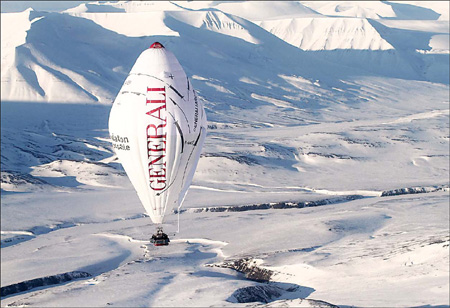Global General
Arctic thaw may yield laughing gas
(China Daily)
Updated: 2010-04-06 08:08
 |
Large Medium Small |
Greenland study shows emissions can surge with melt
OSLO - Thawing permafrost can release nitrous oxide, also known as laughing gas, a contributor to climate change that has been largely overlooked in the Arctic, a study showed on Sunday.
 LOOK OUT, SANTA - NEW AIR TRAFFIC OVER THE NORTH POLE
A handout photo provided by Generali Arctic Observer shows the hot air balloon of French doctor and explorer Jean-Louis Etienne shortly after takeoff on Monday from Longyearbyen in the Norwegian archipeleago of Spitzberg. Etienne is attempting the first solo crossing of the North Pole aboard a hot-air balloon - a seven- to 10-day, 3,500-km journey, that should take him to Alaska. [Agencies] |
The report in the journal Nature Geoscience indicated that emissions of the gas surged under certain conditions from melting permafrost that underlies about 25 percent of land in the Northern Hemisphere.
Emissions of the gas measured from thawing wetlands in Zackenberg in eastern Greenland leaped 20 times to levels found in tropical forests, which are among the main natural sources of the heat-trapping gas.
"Measurements of nitrous oxide production permafrost samples from five additional wetland sites in the high Arctic indicate that the rates of nitrous oxide production observed in the Zackenberg soils may be in the low range," the study said.
The scientists, from Denmark and Norway, studied other Arctic sites as well as their main focus, Zackenberg. The releases would be a small addition to known impacts of global warming.
Nitrous oxide is the third most important greenhouse gas from human activities, dominated by carbon dioxide ahead of methane.
It is among the gases regulated by the UN's Kyoto Protocol for limiting global warming that could spur more sandstorms, floods, heatwaves and rising sea levels.
Nitrous oxide comes from human sources including agriculture, especially nitrogen-based fertilizers, and use of fossil fuels as well as natural sources in soil and water, such as microbes in wet tropical forests.
The scientists said that past studies had reckoned that carbon dioxide and methane were released by a thaw of permafrost while nitrous oxide stayed locked up.
"Thawing and drainage of the soils had little impact on nitrous oxide production," Nature said in a statement of the study led by Bo Elberling of Copenhagen University.
"However, re-saturation of the drained soils with meltwater from the frozen soils - as would happen following thawing - increased nitrous oxide production by over 20 times," it said.
"Nearly a third of the nitrous oxide produced in this process escaped into the atmosphere," it added.
Reuters






